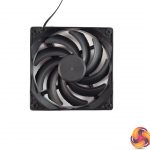Arctic Freezer 33 Plus
The Arctic Freezer 33 Plus is a very conventional air tower. Its heatsink is made from aluminium and it uses 4 copper heatpipes, while its height and width of 150mm and 52mm respectively mean that it is also quite diminutive. It comes with a pair of semi-passive F12 fans, meaning they actually stop spinning when the PWM single drops below 40%.
Installation on our AM4 motherboard was a doddle as the cooler uses the stock backplate: all you need to do is attach two mounting arms to the heatsink, and screw those arms into the backplate. It will barely take 2 minutes.
Cooler Master MasterLiquid 120
Our first liquid cooler, the MasterLiquid 120 from Cooler Master looks quite similar to the MasterLiquid Pro 280 we reviewed previously, but it is obviously a smaller 120mm unit. It does come with two 120mm Air Balance fans, though, which is something I always like to see given the positive effect a push/pull configuration can have.
Installation is by far the easiest of any cooler today, as both the stock backplate and mounting bracket are used. All you need to do is attach two small clips to the cooler's pump, and those clips lock onto the stock bracket. It is essentially like installing an old AMD stock cooler. It still feels secure, though, so I am not complaining at all.
Deepcool Captain 240 EX
We have already reviewed the Deepcool Captain 240 EX on our Intel test bed, but we thought it would be well worth looking at again on the new AM4 platform. The Captain 240 EX definitely has the edge when it comes to aesthetics: the all-white radiator is stunning, while the pump/waterblock also has some exposed hardline tubing which pulses when turned on.
While installation is not exactly hard, it is a bit long-winded: users have to change the stock backplate for Deepcool's own, position two rails on-top of four spacers (and then secure the rails with 4 nuts) and then mount the CPU. As I say, it is not difficult but all the different steps can be a little fiddly.
OCUK Tech Labs 240mm
An interesting addition to our comparison test today, the OCUK Tech Labs 240 AIO is a Gen5 Asetek cooler that has not been modified at all, meaning it is one of the cheapest 240mm liquid coolers around. It ships with two SilverStone 120mm FQ121WC fans, as well as the usual brackets and screws.
Installation is identical to any other Asetek AM4 cooler – it uses the stock backplate, and four screws attach to the backplate. The AM4 bracket is then placed on-top of the screws and is secured with 4 thumbscrews, so all you have to do after that is lock the pump into place by positioning it on-top of the CPU and rotating it slightly.
Scythe Mugen 5 PCGH Edition
An update to the popular Mugen 5, the Scythe Mugen 5 PCGH Edition has a focus on silence: its two 120mm fans have a maximum speed of just 800rpm, so hopefully it should be very quiet indeed. It is also a well-sized heatsink sporting 6 capped heatpipes, and all-in-all it looks quite swish.
Installation of the cooler is quite easy, thanks in-part to the provided screwdriver. Using the stock backplate, four spacers are positioned over the socket holes and two rails are placed on-top. The cooler's pre-installed bracket then screws into these rails, so it is an easy and simple process.
 KitGuru KitGuru.net – Tech News | Hardware News | Hardware Reviews | IOS | Mobile | Gaming | Graphics Cards
KitGuru KitGuru.net – Tech News | Hardware News | Hardware Reviews | IOS | Mobile | Gaming | Graphics Cards



























Thx, for the Scythe Muggen PCGH Review. Waiting a long time for a review of the pcgh version.
Why not the CM MasterLiquid 240? It’s the same packaging, pump, braided tubing just with the larger radiator. I picked it up around a month ago and was surprised to find the AM4 kit inside, surely a first. It cost me £69.99 and I’m sure it would have walked away with an award.
Where’s the Arctic Liquid Freezer 240, the best value in a Ryzen cooler right now?
Over all, this isnt a good look for the stock coolers relative, and surely performance & life sapping, absolute numbers.
I saw no mention of cooling chipsets, which could get seriously warm with onboard sata raid arrays etc.
I think i would pay a premium for a multi heatsink unit.
A simple Cheap ass suggestion.
Contrive a $20 12v tire pump, jetting air via the hose onto the stock wraith heatsink fins at the base via an inserted ball inflating nozzle e.g.
a fan on the compressor head & BoyleS law, should mean the air jet is quite frigid (& pulsing, which may help).
u could even contrive a reserve “tank”/extra cooling, using any tire.
Two questions about your idea; cost? noise?
Tyre type compressors are generally noisy and move little volume of air
It wouldn’t do .much to cool itema
Just wonking.
Cost is cheap as i said, noisy if close – yes.
Quiet ~modern fridge compressors I hear, use “free piston” pumps, a concept i just love.
The mechanically unconnected piston, is reciprocated magnetically.
Yep, not much volume, but precisely targeted and frigid. u already have volume from the existing fan which remains, but as we see, it has its limits..
I also like the idea of two opposing jets (~as per prev post), directed at the hottest, base center of the processor heatsink – create a mini hi pressure, pulsing cyclone there.
The notion is not “always on”, its a turbo mode if needed – like gaming. If CPU cooler, ryzen auto overclocks – simple.
with a tank, as described, it could run quiet for some hours – borrow a colleagues spare tire & deflate that – he wont mind 🙂
i wish they tested the stock wraith cooler.